Gilda (1946)
Who is the blogger?
archived entry
 “There never was a woman like Gilda!” There never was a film like “Gilda”. TVO’s discussion of the Femme Fatale during the Interviews (Aug.18/07) examines Rita Hayworth and the fascinating subject of the female role in film noir.
“There never was a woman like Gilda!” There never was a film like “Gilda”. TVO’s discussion of the Femme Fatale during the Interviews (Aug.18/07) examines Rita Hayworth and the fascinating subject of the female role in film noir.
Video trailer of "Gilda" (1946)
I hurt my back a week or so ago. Youch! The injury? Bending over and tying my shoelaces. While I was sitting down. On the toilet seat, if you must know, with the toilet lid closed. I had just finished with my exercises for the day and was taking off my running shoes. I spent the rest of the day hobbling around with the aid of a broomstick. I spent the rest of the week wondering whether I had done right to leave my broomstick behind whenever I went out the door.
Now, does this mean that I will never engage in exercise again for fear of injuring my back? Never wear shoes with shoelaces? Never sit on a toilet seat ? Well, I could do that, but it would curtail my lifestyle pretty severely, not to mention being unhealthy. (Never sit on a toilet seat again? Let’s not go there in terms of healthy lifestyle choices. I could get into the debatable medical merits of “squatting”, but . . . )
 Both life’s experiences and considerable stud y have taught me that the human body has immense recuperative powers, provided that we don’t get in the way. . .
Both life’s experiences and considerable stud y have taught me that the human body has immense recuperative powers, provided that we don’t get in the way. . .
“I knew it scared her. Anyone as superstitious as Gilda . . .asking for disaster,” The voice over narrative of Johnny Farrell played by Glenn Ford provides us with clues as to the “proper” interpretation of different dramatic and psychological elements of this film. The character of Gilda definitely has her foibles, superstition being one of them. Gilda’s superstitious streak makes for a nice touch, helping to create the sense of foreboding that is so deliciously played up in this film noir classic.
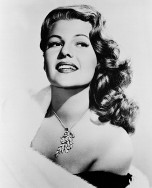 Superstitious though she may be, Johnny’s observation about his “ex” manages to avoid the one most obvious thing about Gilda: she’s a knock-out. Rita Hayworth in 1946 in her heyday is quite the sight. Rita’s former career as a dancer, the extra electrolysis work on moving back the hairline, the red hair dye, the post-pregnancy girdle, the song dubbing by Anita Ellis; it all works together to create a marvelous onscreen effect.
Superstitious though she may be, Johnny’s observation about his “ex” manages to avoid the one most obvious thing about Gilda: she’s a knock-out. Rita Hayworth in 1946 in her heyday is quite the sight. Rita’s former career as a dancer, the extra electrolysis work on moving back the hairline, the red hair dye, the post-pregnancy girdle, the song dubbing by Anita Ellis; it all works together to create a marvelous onscreen effect.
Oops! Maybe I’ve revealed a tad too much. Nothing that you couldn’t find out for yourself through a few minutes of research on INDb. Well, these were just minor “enhancements”. The rest of what we saw onscreen with Rita was all the genuine article. Maybe Rita Hayworth was limited as a songstress, merely good as a dancer, and perfectly adequate as an actress, but, what with a bit of movie magic to set off her natural endowments, she sure looked great onscreen.
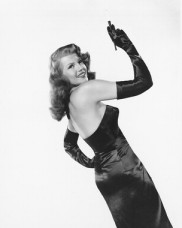 The more I watch the film the more I am convinced that it was no small feat for Rita as an actress to pull off the delicate balancing act that the role of Gilda requires. Gilda is both the irresistibly alluring siren and the vulnerable victim of circumstance. It keeps us all nicely off balance during the film as we run back and forth between these two alternative explanations of the Gilda character.
The more I watch the film the more I am convinced that it was no small feat for Rita as an actress to pull off the delicate balancing act that the role of Gilda requires. Gilda is both the irresistibly alluring siren and the vulnerable victim of circumstance. It keeps us all nicely off balance during the film as we run back and forth between these two alternative explanations of the Gilda character.
We can hardly believe our eyes because the visual image of Gilda and the playacting are so powerful. The truth lies somewhere in between. In my opinion, Gilda is both; victim and vixen. No wonder Johnny is confused! Everything about Gilda says one thing about her but in the end, we are called upon to believe the complete opposite.

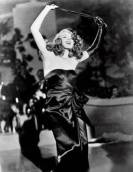 The two versions of the song “Put the Blame on Mame” displayed in the film nicely frame the two competing versions of Gilda. On the one hand, Gilda as the nightclub performer is a brazen, devil-may-care chanteuse who can’t help but drive all the men in the joint wild. On the other hand, the private screening of the same song for Uncle Pio reveals a different side to Gilda. She is fragile, human, full of desperate yearning.
The two versions of the song “Put the Blame on Mame” displayed in the film nicely frame the two competing versions of Gilda. On the one hand, Gilda as the nightclub performer is a brazen, devil-may-care chanteuse who can’t help but drive all the men in the joint wild. On the other hand, the private screening of the same song for Uncle Pio reveals a different side to Gilda. She is fragile, human, full of desperate yearning.
Gilda’s role calls for some emotional verity to make this duality believable. If we can’t believe that Gilda is for real when she is emotionally naked in the empty nightclub as she sings to Uncle Pio, the film just doesn’t work. I for one, think that Rita is able to pull it off.
Conveniently, the Hollywood Hays Code works in collusion with Gilda to limit what the audience sees of her misadventures. There are lots of intimations, but few facts actually available. Basically, we only see what Gilda wants us to see and what the producers agree to let us see. We’re in something as the same boat as Johnny Farrell when it comes to figuring out Gilda. It’s a great recipe for getting people all hot and bothered.
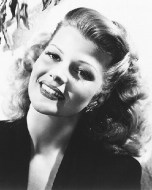 Apparently people did get all hot and bothered about this film at the time. It’s not all that hard to imagine why. This is the film that defined Rita Hayworth as one of the most famous pinup girls of the era. In one scene just before the dénouement at the end, Rita gives us one glimpse of “the girl next door” look as she glances back over her shoulder at Uncle Pio over the empty bar. The moment is notable if only because it is so uncharacteristic of Rita in this film. Intentionally sultry and sizzling might be better words for Gilda’s look during the rest of the movie.
Apparently people did get all hot and bothered about this film at the time. It’s not all that hard to imagine why. This is the film that defined Rita Hayworth as one of the most famous pinup girls of the era. In one scene just before the dénouement at the end, Rita gives us one glimpse of “the girl next door” look as she glances back over her shoulder at Uncle Pio over the empty bar. The moment is notable if only because it is so uncharacteristic of Rita in this film. Intentionally sultry and sizzling might be better words for Gilda’s look during the rest of the movie.
As for Johnny – well, the understated Glenn Ford does a pretty good job of going from the rumpled look of the “down-on-his-luck” drifter to the carefully pressed look of the nouveau riche as Mundson’s invaluable henchman. Mundson refers to his newly acquired lackey boy as his “little friend”. Uncle Pio insists on calling him “a peasant”. Gilda says that Johnny is just plain “cockeyed”. It seems that no matter how you dress him up, Glenn Ford as Johnny Farrell “just don’t get no respect”.
The “cockeyed” look that Johnny wears so well throughout the film seems to be made up of one part gambling addict, two parts hustler, and one part jealous ex-lover. As Johnny supposedly consolidates his control over the situation, his vantage point on reality becomes more and more skewed. It’s as if he’s spent too much time peering through those horizontal blinds up in Mundson’s office.
 Eventually, Johnny’s empire is starting to crumble and fall through his fingers. Police detective Obregon spends quite a bit of time setting Johnny straight. Obregon chastises Johnny as he places him under house arrest: “How dumb can a man be! I’ll have to get out of here before you realize what a heel you’ve been. I couldn’t bear to see you break down and feel like a human being. I’m a very sensitive man for a cop.”
Eventually, Johnny’s empire is starting to crumble and fall through his fingers. Police detective Obregon spends quite a bit of time setting Johnny straight. Obregon chastises Johnny as he places him under house arrest: “How dumb can a man be! I’ll have to get out of here before you realize what a heel you’ve been. I couldn’t bear to see you break down and feel like a human being. I’m a very sensitive man for a cop.”
Obregon’s inside information is supposed to make the surprising turnaround in the next scene a possibility. Low and behold, Obregon’s prediction is exactly what happens to Johnny in the next scene. Johnny eats a giant sized slice of humble pie: “I know I did everything wrong . . .I want to go with you. Please take me.”
The amazing thing is that for once in his life, Johnny isn’t playing the con. Two people who by their own admission are great one’s for getting revenge finally come to the place of burying the hatchet through being more honest with each other than they’ve been in a long time. It’s time to call it quits on “the game”.
 However, before the obligatory happy ending can ensue, one further plot complication in the form of Ballin Mundson has to be laid to rest. Aside from providing a properly dramatic conclusion for the story, the event of the Mr. Mundson’s dispatching also provides the opportunity for Johnny’s character to expand into a new role; that of hero. Johnny steps up to defend Gilda; Uncle Pio defends Johnny as “the gentleman I always knew he
However, before the obligatory happy ending can ensue, one further plot complication in the form of Ballin Mundson has to be laid to rest. Aside from providing a properly dramatic conclusion for the story, the event of the Mr. Mundson’s dispatching also provides the opportunity for Johnny’s character to expand into a new role; that of hero. Johnny steps up to defend Gilda; Uncle Pio defends Johnny as “the gentleman I always knew he 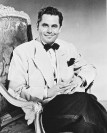 was”. Although Detective Obragado maintains that Uncle Pio and Johnny can quit being noble any time (because he’s not going to arrest either on of them for a capital offense), this is a good old fashioned type of morality play that ultimately tells us that “handsome is as handsome does.”
was”. Although Detective Obragado maintains that Uncle Pio and Johnny can quit being noble any time (because he’s not going to arrest either on of them for a capital offense), this is a good old fashioned type of morality play that ultimately tells us that “handsome is as handsome does.”
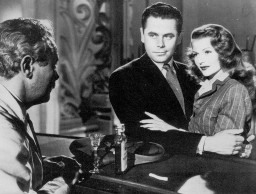 I’m with Detective Obragado on this one when it comes to “Gilda”. Like many of the original viewing audience and probably like many others still today, “I’m a sucker for a love story.”
I’m with Detective Obragado on this one when it comes to “Gilda”. Like many of the original viewing audience and probably like many others still today, “I’m a sucker for a love story.”
Suggested Explorations in Cyberspace
- Ouch! That must have hurt! – It is reported that Rita actually broke Glenn Ford’s tooth with her “slapshot” during the filming of “Gilda”.
- Rita, herself, said, "Every man I have known has fallen in love with Gilda and wakened with me." Be Loved for Who You Are
- Johnny and Gilda: Soul Mates- Does it work for you? (Video: Use Internet Explorer and punch “segment one”)
- What Gilda Wanted (?): Exclusive Entanglement
- How can anyone believe that silly happy ending stuff anyways? Video: Venia – Forgiveness
- Because everyone’s a stinker, now and again: starting over.





Reader Comments